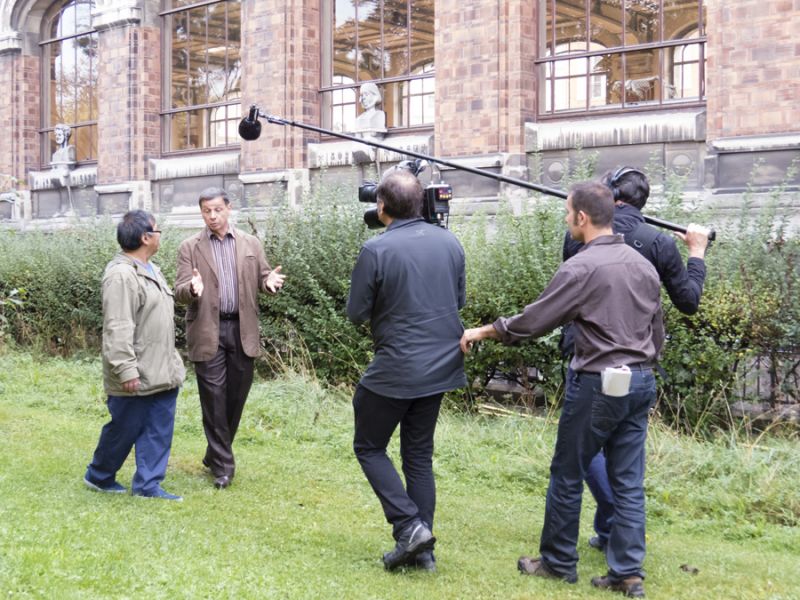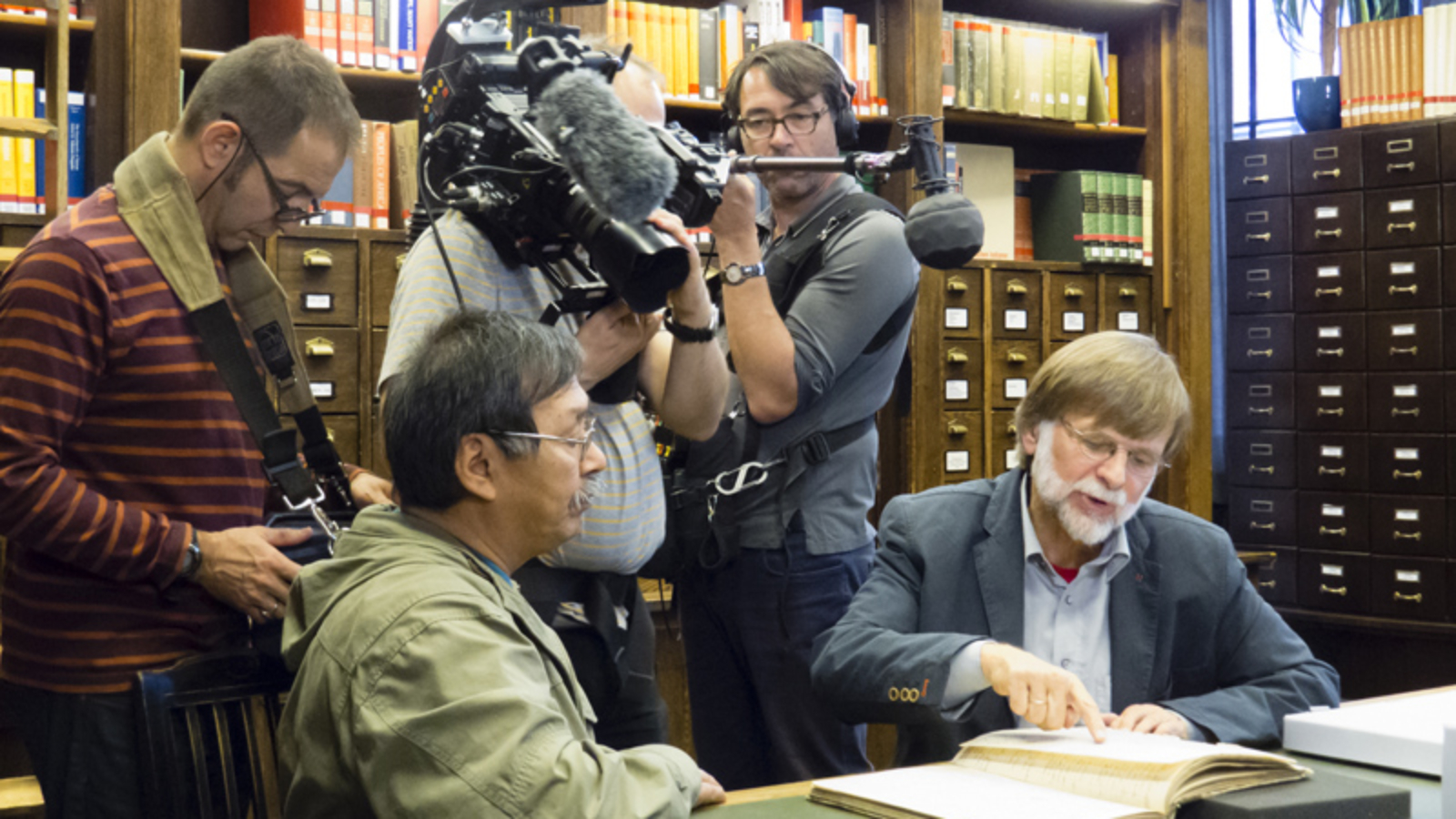This article was originally published in Inukitut Magazine.
For two weeks during September and October 2014, Nunatsiavut elder Johannes Lampe retraced the footsteps of a group of Labrador Inuit who died more than 100 years earlier in Europe. He navigated the Elbe River to better understand what those men and women first saw when they landed in these far away lands, and felt the homesickness that beset them soon after they arrived. At the Muséum national d’Histoire Naturelle in Paris, France, Lampe saw the human remains of these individuals, kept in standing positions, and decided to bring them home.
by France Rivet
The story begins in August 1880, when a 35-year-old Inuk named Abraham, living in Hebron (in what is now Nunatsiavut), accepted an offer to be exhibited in an ethnographic show in Europe for a year, in exchange for money. The offer came from Johan Adrian Jacobsen, who was traveling the coast to recruit Inuit on behalf of Carl Hagenbeck, a menagerie owner in Hamburg. Since 1874, crowds had been flocking to Hagenbeck’s shows, where they could observe “savages” originating from different parts of the world. Hagenbeck was hoping to repeat the 1877 success brought by a group of Greenlandic Inuit.
Abraham had heard stories of Inuit who had traveled to Europe and returned to Greenland with the latest clothing of the era and tall tales from the big city. He was indebted to the general store owned and operated by Moravian Missionaries, and he took this monetary opportunity as a sign from God, which would allow him to improve his family’s living conditions. Abraham was of the Moravian faith, and had heard much about Europe from missionaries in his community. He was hoping to visit Herrnhut, the center of the Moravian Church, to meet some of the missionaries who had previously worked in Labrador.
So he agreed to make the journey, along with his wife, Ulrike, 24, and their two young daughters, Sara, 3, and Maria, then a 9-month-old. Several other Inuit made the journey—a single man from Hebron named Tobias, 20, another family from Nachvak, Tigianniak, 45, his wife Paingu, 50, and their daughter Nuggasak, 15.
The group boarded the schooner Eisbär (German for polar bear) and headed to Europe. They arrived in Hamburg in September 1880, and performed in several cities throughout Germany, as well as Prague and Paris. Almost immediately, they longed to return home.
“It is too long until the year is over because we would very much like to return to our country, because we are unable to stay here forever, yes indeed, it is impossible,” Abraham wrote in October. And in January, he added, “I do not long for earthly possessions, but this is what I long for: to see my relatives again, who are over there.”
Soon after Abraham penned that last passage, all eight had died of smallpox.
In July 2009, I was a passenger on an Arctic cruise. As we approached Hebron, I read a copy of The Diary of Abraham Ulrikab, which had been donated to the ship’s library. I was stunned by the story and moved by Abraham’s words. At the end of the story, Abraham and Ulrike were forced to leave their daughter Sara at a German hospital. She died on December 31, 1880, as her parents arrived in Paris. Soon after, Abraham’s diary goes silent.
I wanted to know what happened in Paris. That part of the story was absent from the book. So when I returned home, I started researching. I soon uncovered documents revealing that Paingu’s skullcap as well as three plaster casts of Inuit brains had been presented to the Société d’anthropologie de Paris.

I contacted museums in Paris to inquire if they still had these items in their collections. Soon after, a reply arrived from the Muséum national d’Histoire Naturelle. They didn’t have the casts. But they owned the skullcap as well as the fully mounted skeletons of Abraham, Ulrike, Maria, Tobias, and Tigianniak, the five Inuit who died in Paris in January 1881. I could not bring Abraham home alive, but I could help him find his homeland once again.
Two months later, I was sitting in the curator’s office in Paris. He explained that, since the remains have an identity, the museum would not dispute a request for repatriation. He also took me into the reserves to see the skeletons, which are part of a collection of about 2,000 (as well as some 18,000 skulls).
From 2011 to 2013, I contacted the diplomatic authorities in Nunatsiavut, Ottawa, Paris, and Berlin, and I traveled to Europe to gather as many 19th century documents and photographs as possible in order to provide the decision makers with a comprehensive picture of the past events.
Along the way, film producer Roch Brunette (Pix3 Films), heard about Abraham’s story and my research through a local newspaper article published in the Ottawa-Gatineau region. Intrigued, he got in touch with me. A year later, he had gathered the support of Canadian TV broadcasters as well as the required financing to start filming a documentary, Trapped in a Human Zoo. As part of my participation in the documentary, I traveled with Johannes Lampe to Hamburg, Berlin, and Paris to retrace Abraham’s footsteps. The most moving and disturbing moment of the trip was undoubtedly our visit to the reserves where the human remains are kept.
We cannot change the past, but we can today take steps to do the right thing. As Lampe explained, through the mysterious appearance of a butterfly in the library of the Museum of Ethnology in Hamburg, the spirits found a way of telling us that they were delighted with the steps that are currently being taken to bring the human remains back to Labrador. It should be just a matter of time before they can be set free.
The Nunatsiavut government is currently in the process of defining its repatriation policy, and trying to identify any living descendants of Abraham’s and Tigianniak’s families. If any surviving descendants are identified, they will be invited to discuss the next steps in the possible repatriation process with Inuit elders and members of the Nunatsiavut Government’s Executive Council.
Trapped in a Human Zoo, a Pix3 Films production, is scheduled to air in fall 2015 on CBC’s The Nature of Things with David Suzuki, and is to be presented at film festivals, and other venues, starting in 2016.
*****
*****
France Rivet is the founder of Polar Horizons, an enterprise that promotes greater awareness and appreciation of the Arctic, its nature, people, and history. Rivet is also the author of In the Footsteps of Abraham Ulrikab, published by Polar Horizons in September 2014. For more information, visit www.abrahamulrikab.com.
[Photos courtesy of France Rivet]
